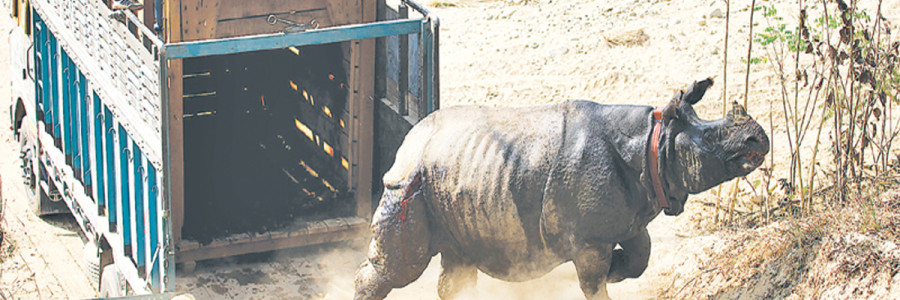Miscellaneous
A new home for rhinos
By 2003, 87 rhinos were translocated through seven separate events in Bardia National Park and Shuklaphanta Wildlife Reserve. As a positive trend, 27 calves were born in Bardia between 1986 and 2000. However, in Babai Valley of Bardia National Park, where a majority of the rhinos had been translocated, almost all of the rhino population was wiped out on account of poaching during the peak insurgency period between 2002 and 2006.
Text: Abdullah Miya
Photos: Kiran Panday
Translocating rhinos is no easy endeavour. These pachyderms, which can weigh up to 2,400 kg, are very nervous in temperament and can be quite aggressive. In January, the Ministry of Forest and Soil Conservation began preparations to translocate 30 rhinos from Chitwan National Park to Bardia National Park (25 rhinos) and Shuklaphanta Wildlife Reserve (five rhinos) through 2018, the first leg of which, the translocation of three rhinos from Chitwan to the Babai Valley in Bardiya, took place over the past week.


Rhino translocation in Nepal dates back to 1986 when a batch of 13 rhinos was translocated from Chitwan National Park to Bardia National Park. By 2003, 87 rhinos were translocated through seven separate events in Bardia National Park and Shuklaphanta Wildlife Reserve. As a positive trend, 27 calves were born in Bardia between 1986 and 2000. However, in Babai Valley of Bardia National Park, where a majority of the rhinos had been translocated, almost all of the rhino population was wiped out on account of poaching during the peak insurgency period between 2002 and 2006.

Determined to learn from past shortcomings, the preparations for this leg of translocations began early. At the National Nature Conservation Fund’s premises in Sauraha, 40 personnel in total worked for two weeks to construct three cages—13 ft long, six ft wide and nine ft tall—out of dry Saal trees gathered from the park. The cages were then fenced with iron rods in order to protect them from any possible breakage. On the eve of February 29, the cages were taken to the Sukhibhar Area of the park where the technical team started camping in preparation for the translocation. Before sunrise on March 1, a team of wildlife specialists, technicians, National Park officials and journalists, led by rhino specialist Dr Shantaraj Gyanwali, strolled from the head office of the park towards Kasara, Sukhibhar. The technicians loaded the dart guns with syringes filled with the tranquiliser M 99 and a total of 33 rhinos were readied. Such tranquilisers specifically require adult rhinos, and even after a thorough search in the morning, no such suitable rhino was found. Finally at around 4:30 am, one rider spotted a suitable adult rhino. The rhino was soon sedated, put on a wooden sledge and hauled to the cages. The rhino was then loaded onto a truck towards Bardiya, 415 km away. The transport was followed by a team of veterinarians who made it a point to check on the rhino every two hours of the 12-hour journey.


Bardiya has had to wait 13 years for rhinos to set foot in its national park again. It came as little surprise that locals were jubilant when the team arrived with the rhino in tow, and welcomed them enthusiastically. The team was received warmly and was feted by the locals, many of whom were holding placards saying Gainda Bachauana Saksham Chhau—We can protect the rhinos.
At 11:06:28 on March 2, the first rhino of this ambitious endeavour sprinted from the cages into its new home—the Babai Valley.


Nepal has achieved 365 days of zero poaching of rhinos on three separate occasions since 2011, and Nepal’s rhino population is growing—with 645 rhinos recorded in the country in 2015. In Bardia alone, rhino populations grew from 24 to 29 as compared to the previous count in 2011. Given the top-level commitment in rhino conservation, a well-coordinated protection response between the national parks, Nepal Army, Nepal Police and local communities, and the support of conservation partners such as WWF and the National Trust for Nature Conservation, Nepal’s rhino population is in the upswing. These translocations will further help stabilise the rhino populations at Bardiya and Shukulaphanta and as the first rhino headed into the forest cover, one couldn’t help but feel that an important milestone in Nepal’s rhino conservation efforts had been reached.







 17.12°C Kathmandu
17.12°C Kathmandu







%20(1).jpg&w=300&height=200)

